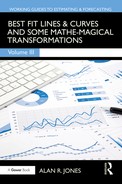Foreword to the Working Guides to Estimating and Forecasting series
At long last, a book that will support you throughout your career as an estimator and any other career where you need to manipulate, analyse and, more importantly, make decisions using your results. Do not be concerned that the book consists of five volumes as the book is organised into five distinct sections. Whether you are an absolute beginner or an experienced estimator there will be something for you in these books!
Volume One provides the reader with the core underpinning good-practice required when estimating. Many books miss out the need for auditability of your process, clarity of your approach and the techniques you have used. Here, Alan Jones guides you on presenting the basis of your estimate, ensuring you can justify your decisions, evidence these and most of all ensure you keep the focus and understand and focus on the purpose of the model. By the end of this volume you will know how to use, for example, e.g. factors and ratios to support data normalisation and how to evidence qualitative judgement. The next volume then leads you through the realm of probability and statistics. This will be useful for Undergraduate students through to experienced professional engineers. The purpose of Volume Two is to ensure the reader understands the techniques they will be using as well as identifying whether the relationships are statistically significant. By the end of this volume you will be able to analyse data, use the appropriate statistical techniques and be able to determine whether a data point is an outlier or not. Alan then leads us into methods to assist us in presenting non-linear relationships as linear relationships. He presents examples and illustrations for single linear relationships to multi-linear dimensions. Here you do need to have a grasp of the mathematics and the examples and key points highlighted throughout the volumes ensure you can. By the end of this volume you will really grasp best-fit lines and curves.
After Volume Three the focus moves to other influences on your estimates. Volume Four brings out the concept of learning curves – as well as unlearning curves! Throughout this volume you will start with the science behind learning curves but unlike other books, you will get the whole picture. What happens across shared projects and learning, what happens if you have a break in production and have to restart learning. This volume covers the breadth of scenarios that may occur and more importantly how to build these into your estimation process. In my view covering the various types of learning and reflecting these back to real life scenarios is the big win. As stated many authors focus on learning curves and assume a certain pattern of behaviour. Alan provides you with options, explains these and guides you on how to use them.
The final volume tackles risk and uncertainty. Naturally Monte-Carlo simulation is introduced and a guide on really understanding what you are doing. One of the real winners here is some clear hints on guidance on good practice and what to avoid doing. To finalise the book, Alan reflects on the future of Manufacturing where this encompasses the whole life cycle. From his background in Aerospace he can demonstrate the need for critical path in design, manufacture and support along with schedule risk. By considering uncertainty in combination with queueing theory, especially in the spares and repairs domain, Alan demonstrates how the build-up of knowledge from the five volumes can be used to estimate and optimise the whole lifecycle costs of a product and combined services.
I have been waiting for this book to be published for a while and I am grateful for all the work Alan has undertaken to provide what I believe to be a seminal piece of work on the mathematical techniques and methods required to become a great cost estimator. My advice would be for every University Library and every cost estimating team (and beyond) to buy this book. It will serve you through your whole career.
Linda Newnes
Professor of Cost Engineering
Department of Mechanical Engineering
University of Bath
BA2 7AY
